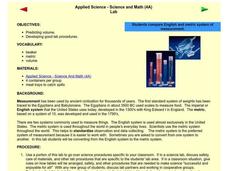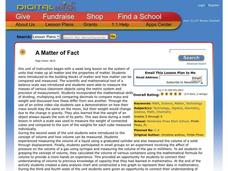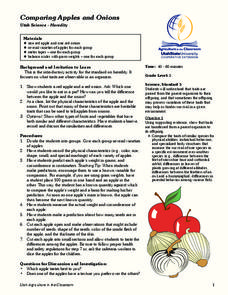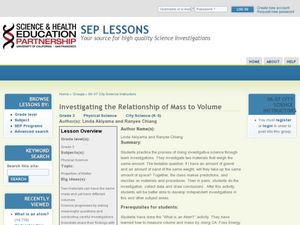Curated OER
Applied Science - Science and Math Lab
Although it was written to use in a science class, this measurement instructional activity is adaptable to Common Core standards in math for measurement and data. Youngsters are introduced to two types of measurement systems. They...
Curated OER
Perimeter All Around
Students explore perimeter and area of regular and irregular polygons. They experiment with color squares and create different arrangements using the same number squares. Then they compare the area and perimeter measurements of each.
Curated OER
"Mummies--The Great Cover Up"
Students wrap their mummy, use canopic-style jars for the preserved chicken organs and design and decorate a sarcophagus. They collect data by weighing, measuring and graphing their "mummy" and its organs.
Curated OER
A Matter of Fact
Students design their own Science experiment. For this science experiment lesson students create a hypothesis related to matter and test it. They displayed their data in a graph.
Curated OER
How Can You See Which Soda Has More Sugar?
Sixth graders weigh regular and diet soda to see which one is heavier and therefore which one contains more sugar. In this soda lesson plan, 6th graders discover that regular soda contains more sugar because it weighs more.
Curated OER
Measurement
Students use arithmetic in a practical situation using time and distance.
As the calculations involved in this problem involve single digit addition and multiplication it offers a good opportunity to encourage the students's use of...
Illustrative Mathematics
How Thick Is a Soda Can II?
Science, technology, and math come together in this one combination exercise. Analyzing the common soda can from both a purely mathematical perspective and a scientific angle allows for a surprisingly sophisticated comparison of...
Cornell University
Buoyancy
Swimmers know to float by turning their bodies horizontally rather than vertically, but why does that make a difference? In an interesting lesson, scholars explore buoyancy and the properties of air and water. They test cups to see which...
Curated OER
Let's Weigh Air
Students participate in an experiment to measure the weight of air by measuring the weight of the mass it displaces. They lift up a desk and a textbook using a toilet plunger, and calculate the weight of the air, or air pressure.
Curated OER
Metrics
Students discover the need for a universal measurement system. They practice using basic metric units in measuring distance and weight.
Curated OER
Grams and Kilograms
Fourth graders participate in scavenger hunts for objects that weigh a gram and a kilogram. In this metric measure lesson, 4th graders use a spring scale to measure objects they believe weigh a gram and a kilogram. Students complete...
Curated OER
Why Cheerios Don't Sink
Students investigate Archimedes' Principle and show how it relates to density. In this Archimedes' Principle lesson plan, students experiment with a beaker of water, a Styrofoam "boat" and a weight. They predict what will happen when the...
Curated OER
Calorie Connection
Students calculate the calories in a Brazil nut and the calories needed for daily intake. For this calories lesson plan, students use calorimetry to measure the change in water temperature heated by the burning of a Brazil nut. They also...
Curated OER
Wheeling It In!
Students use everyday materials (milk cartons, water bottles, pencils, straws, candy) to build a small-scale transportation device that incorporates the wheel and axle and the lever. They race their carts/trucks, measure distance, time...
Curated OER
How Do Things Fall?
Students study forces by examining the force of gravitational attraction. They observe how objects fall and measure the force of gravitational attraction upon objects. Students discover that, since gravitational constants are different...
Curated OER
A Tough Nut to Crack
Children, based on a set of criteria, evaluate the quality of pecans. They research recorded history of pecan trees as well as how their seeds moved across western Missouri into southeastern Kansas, Oklahoma, Texas and Mexico. In...
Curated OER
Egg Hunt
Young scholars make detailed qualitative and quantitative observations. They are introduced to the process of developing repeatable procedures. Students practice collecting data. They review measurement skills. Young scholars become...
Curated OER
Comparing Apples and Onions
Fifth graders observe and compare apples. In this apples lesson, 5th graders work in groups to record the physical characteristics of a variety of apples. Students predict each apples weight and then weigh them to see if they were...
Curated OER
Weather Dot Com
Students examine the need for a standard unit of temperature and measure temperature with a thermometer. They discuss the details of a thermometer and the calibrations used, record temperature data for inside and outside, explore...
Curated OER
By the Pound, Gram Liter or Gallon
Students participate in experiments at five stations to practice measurement. In this measuring lesson, students are presented different produce and objects and must measure with an appropriate tool. Students use metric and customary...
Curated OER
Making Metric And Customary Rulers
Students create a ruler for the purpose of measurement using the standard and metric systems. The rulers are of different lengths and are compared to one another. Then students make conversions of different lengths using both systems of...
Curated OER
Giant Mystery
Third graders determine the relationship between hand size and body size using centimeters as the unit of measure, They use the relationship to find the size of a hypothetical giant. They graph the measurements using a spreadsheet program.
Curated OER
Jelly Bean Math
Students estimate, measure, compute, and create patterns using jelly beans. In small groups, they solve various calculations, place jelly beans into groups, invent a new flavor, create a pattern, and complete a worksheet.
Curated OER
Investigating the Relationship of Mass to Volume
Third graders explore the relationship of mass to volume. In this physical science lesson, 3rd graders participate in an investigation with a several materials and measure the mass and volume using scientific tools. Students discuss and...























